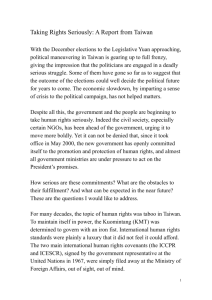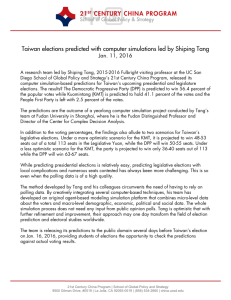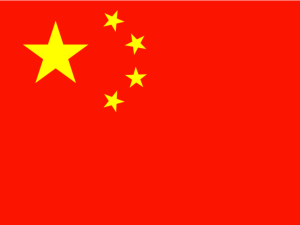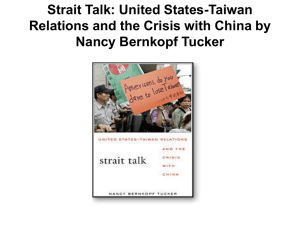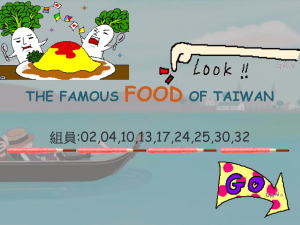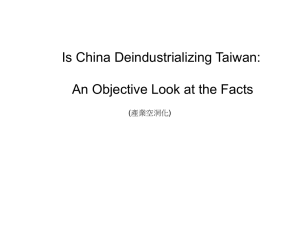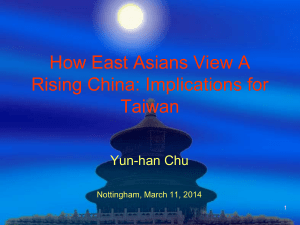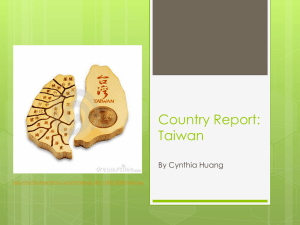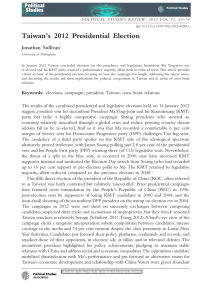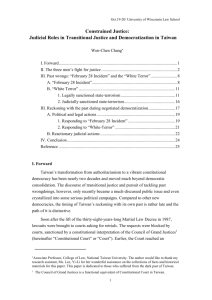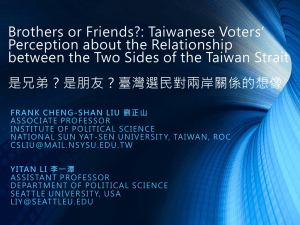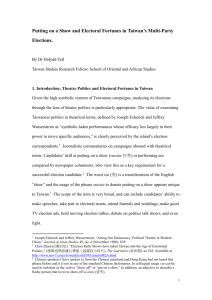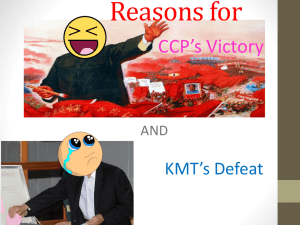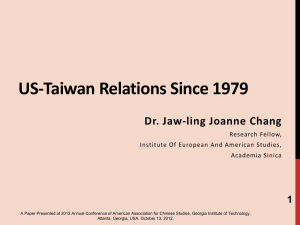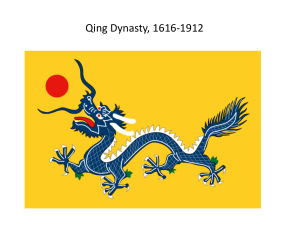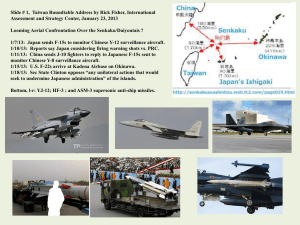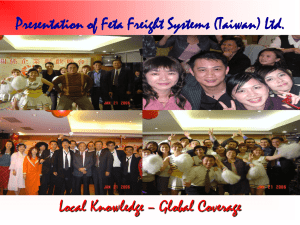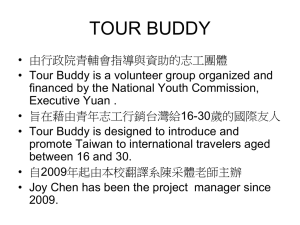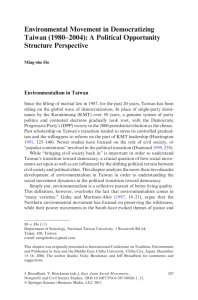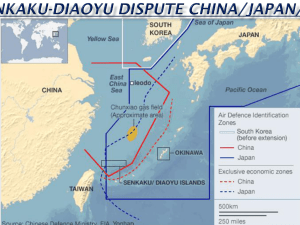The “Independence versus Unification” Issue in Taiwan`s
advertisement
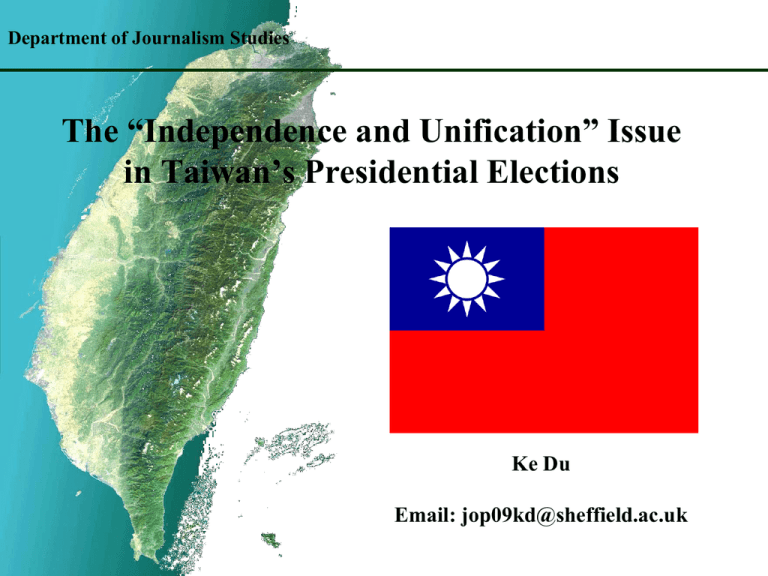
Department of Journalism Studies The “Independence and Unification” Issue in Taiwan’s Presidential Elections Ke Du Email: jop09kd@sheffield.ac.uk Political and Media Reform in Democratising Taiwan • 1945, the nationalist Kuomintang (KMT) retreated from China mainland. In Taiwan, the supreme leader and director-general of the KMT, Chiang Kai-shek, established an authoritarian regime • Martial law. • 1987, Chiang Ching-kuo, opened the political market and revoked the Martial law. • Since the 1990s The political domination of the KMT was ended the rise of opposition voices: the DPP. • By 2003, there were 4 significant political parties operating in Taiwan: the KMT, the DPP, the People First Party (PFP) and the Taiwan Solidarity Union (TSU). However, the KMT and DPP are two major competing political forces. Political forces in this island • the “Pan-Green Coalition” and the “Pan-Blue Coalition”. Significant distinction lies in their positions on the independence-unification issue (Rigger, 2000; Niou, 2005; Alagappa, 2001). • The Pan-Green Coalition : the Democratic Progressive Party (DPP), Taiwan Solidarity Union (TSU), and the minor Taiwan Independence Party (TAIP). This coalition favours Taiwan independence over Chinese reunification. The name comes from the colours of the DPP. • The Pan-Blue Coalition : the KMT, the NP, and the PFP. This coalition was associated with Chinese unification. The name blue comes from colours of the KMT. Political and Media Reform in Democratising Taiwan a distinct phenomenon • Chinese and Taiwanese cultures have common roots (Li, 2005); however, this commonality has been politically separated in the last century. • differentiations of demographic groups, which are also associated with different political positions. • It is shown that from 1996 to 2008, emphasises on the independenceunification issue have been centred on ethnic identity, national identity and cross-strait relations (Huang, 2005; Hsieh, 2005; Rigger, 2000; Schubert, 2004; Tzeng, 2000). • Considerable political reform and the open-up of the media have provided the Taiwanese with more options to devote their support. The Change of Taiwan’s Media Landscape • 1949, Martial Law. Political control of the media remained firm and resolute so as to suppress political dissidents. Taiwan’s martial law period is from May 19, 1949 to July 15, 1987 (Chou and Nathan 1987; Rawnsley and Rawnsley 1998). • government censorship declined and had largely disappeared by the mid1990s (Fell 2005: 882), and a rapid proliferation of legal media. – newspaper industry – national television stations – since 1991, restrictions on election campaigns were lifted. • fiercer party competition aggravated domestic confrontation between supporters of different camps, and ideological confrontations have tended to be quite evident through different parties’ diverse constructions of issues in elections: whether questing for reunification with China or gaining independence. Democratic Elections • 1996, first direct election of president: the KMT • 2000, the first alteration of political power: the DPP • 2004, the DPP’s second triumph • 2008, the second alteration of ruling political party: the KMT The Focus of this Study • The issue of independence versus unification has turned out to be increasingly salient since Taiwan’s progress towards democratisation. • In particular, major political parties’ shifting principles regarding this issue in presidential elections indicate a complex dynamics of Taiwan’s electoral campaigns. • On the one hand, the prevailing campaign appeals concerning “independence versus unification” suggest that political parties have put significant emphasis on this issue. On the other hand, it is evident that the configurations of using this issue by political parties have tended to evolve in the past elections. • Thus, this requires further understanding of how different aspects of the independence-unification issue have been emphasised and how this has evolved in importance in Taiwan’s political and media contexts. Time Period of the Research • This project intends to examine the independence–unification issue by studying Four significant elections during Taiwan’s process of democratisation: 1996, 2000, 2004 and 2008. 1996 2000 2004 2008 The four presidential election s have been called the most important events in Taiwan’s democratic history. Questions Questions to be to addressed be addressed in thisinThesis this Thesis • Firstly, it is concerned with how appeals regarding the issue of independence–unification were shaped and communicated in parties’ presidential elections campaigns: • Secondly, this project also intends to generate knowledge of the relationship between political parties, the media and the public regarding the independence-unification issue in Taiwan’s democratisation process. It would be interesting to find that: • Furthermore, this study examines whether political parties’ exploitation of independence–unification issue in campaigns has direct link to the public’s concept and voting behaviour. This will be examined in terms of how public opinion poll reflected voter’s corresponding reactions. Expectations • This research of the independence-unification issue – incorporates three dimensions: ethnic, national identity and China relationship. – makes a clearer distinction between different time periods – provides an explicit comparison of the content of issue emphasis or change. • This study also investigate party’s evolving attitudes, their use of this issue in campaigns, media’s report of their claims and the equally important rationale behind. – examines the media’s coverage regarding parties’ use of independenceunification issue in elections, which could facilitate the researcher to explore wider influence of this issue upon the society. – In general, it would be interesting to probe whether parties in Taiwan has been stressing identity, competing on the independence-unification issue, and remain clearly differentiated. • In-depth research into presidential campaigns, media materials and political publications – provide abundant evidence to discuss phenomenon and the underlying causes. – predict a possible future for the island’s identity politics and cross-strait relations in terms of the evolving nature of independence-unification issue. – stimulate much further discussion on the topic of what the issue’s possible effects on China-Taiwan relations, cross-Strait stability.
